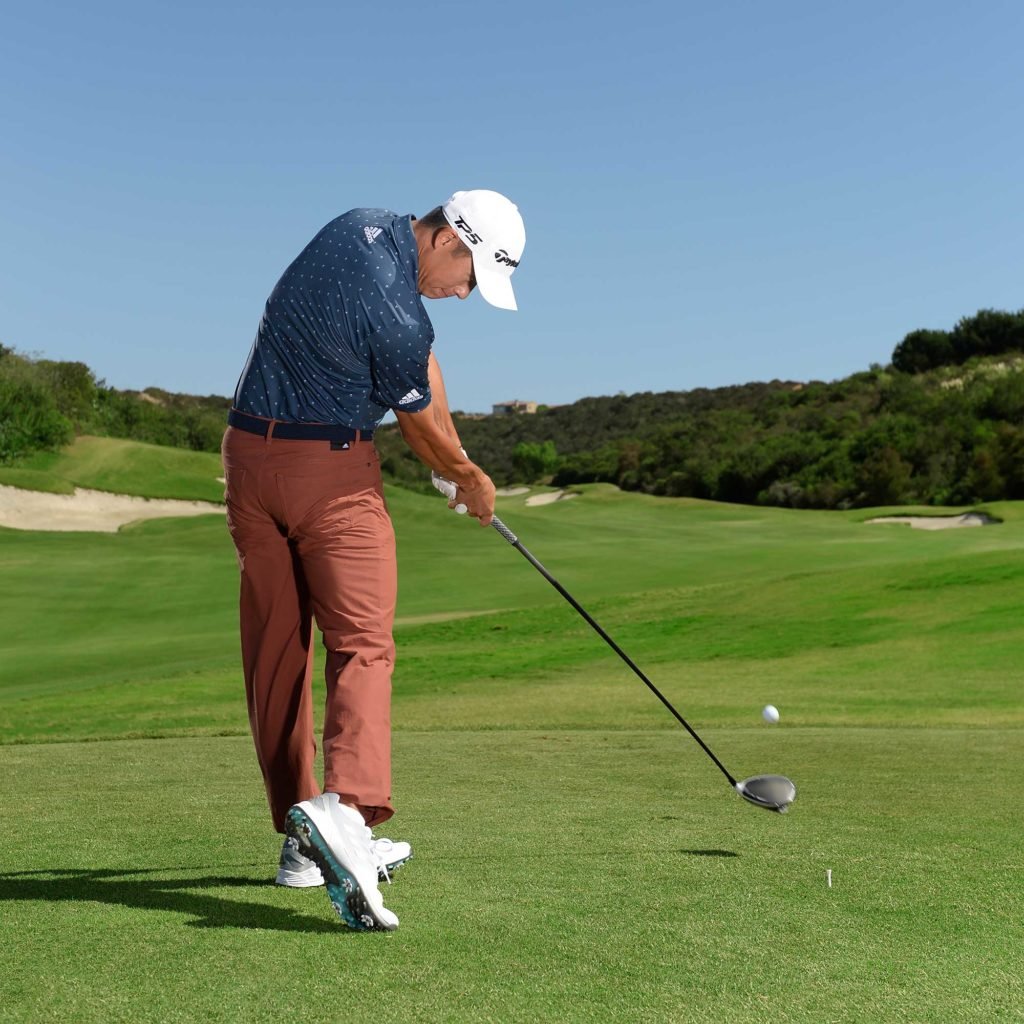Amateurs often stand over the ball with their feet too wide apart. I understand the appeal – they want to feel more stable throughout the swing, and a wider stance seems a logical way to achieve that. Ever notice how many tour pros have both feet anchored to the ground at impact? Not everyone – some pros get up on their toes for more power – but most know having both feet planted is such a stable position when you’re swinging through the hitting zone. It helps provide consistency to ball-striking. That said, there is such a thing as being too wide. It hinders body rotation and truncates the swing. This is something my coach, Rick Sessinghaus, and I keep an eye on as it pops up periodically when I address the ball. When my stance is too wide, my tendency is to slide away from the ball in the backswing, rather than

making a good turn off the ball with my upper body. Often this leads to my right hip sliding outside my right ankle during the backswing, or my right shoulder dropping too much and too far back, getting my swing out of sequence. The club gets blocked by my body in the downswing – we call this “being stuck” – and I leave the face a touch open to my target at impact. If you see me miss with a spinny shot to the right of the fairway or green, I was probably too wide at address.
When amateurs get too wide, their lower body gets locked off and they don’t rotate towards the target in the downswing like they should. The only way they can generate clubhead speed is with their arms. When you swing like that, you become too reliant on timing and the hope that you can get the clubface in a good position for a solid strike with your hands and wrists. Good luck trying to improve consistency.
So how should you stand over the ball? The key is to set your feet just wide enough that you feel stable and balanced – but not so wide so that you can’t arrive at a fully rotated finish position with your belt buckle facing the target. For me, a good checkpoint with a middle iron is making sure that my feet are just a hair wider than my shoulders. This gives me just enough width to keep my head and chest centred over the ball in the backswing, but I’m not so narrow that I can’t fire my hips through and arrive in a balanced finish with my lower body fully uncoiled. When I’m holding any wood, I stand a little wider, but again, not so wide that I feel locked down. If you’re going to err, a little too narrow is better than a little too wide. And you’ll know when you’re too narrow if you can’t maintain your balance during a practice swing. Next time you’re hitting balls or waiting for your next shot on the course, take a second to note the width of your stance and adjust if it appears or feels a little off. It’s easy to forget about width of stance, but a simple tweak can turn your ball-striking around in a big way.
Changing topics, my go-to shot is a cut, and I’ll stick with it on the vast majority of tee shots. You might think pros are always shaping their shots to fit the hole – so for me, fades on dogleg rights and draws on dogleg lefts – but I don’t know anyone who is equally comfortable shaping the ball both ways, and veering away from your stock shot can lead to a big miss. The one exception I’ll make is when it’s windy. If it’s whipping off the left and there’s trouble down the right, I need to hit a shot that draws into the wind and holds its line. Hitting a cut into a 30mph gust coming from the left is a bad idea.
Instead of manipulating my path or my swing to hit a draw, I alter my setup. We know from using launch monitors that to impart the right-to-left spin necessary for a draw, I need to aim my clubface where I want the ball to start and swing on a path that is open when compared to the face. For righties like me, that combination makes the ball start right of the target and then curve towards it, because the face is closed in relation to the path. You can check that here at address [above, left]. For my normal cut setup, you wouldn’t be able to see my left thigh or a sliver of my left arm from this view. Here, my feet and shoulders are aligned a little right of my target and the clubface is set where I want the ball to start.
When it comes to the actual swing, I make an effort to move the club along my foot line, which makes my path in-to-out in relation to the target. If all you did was make this adjustment, you would draw the ball so long as your clubface is closed to that swing path at impact [above]. You don’t need to make big changes to shape it. Simply alter your setup and swing along your body line. – with Daniel Rapaport





